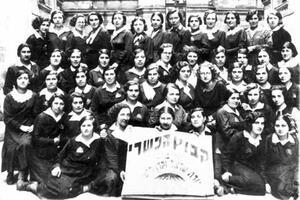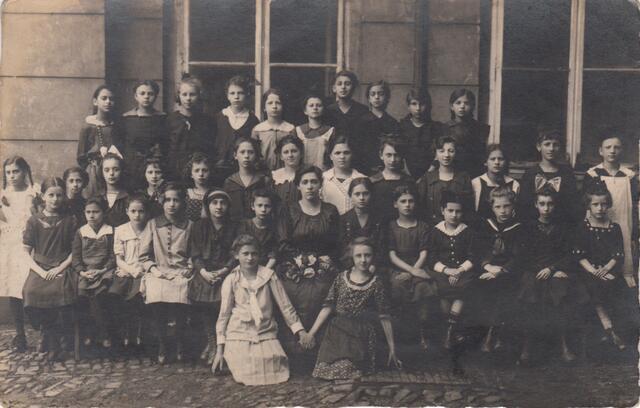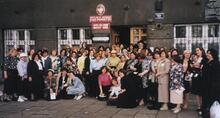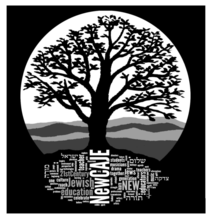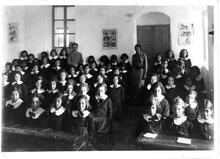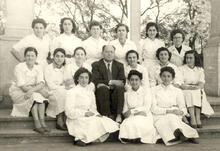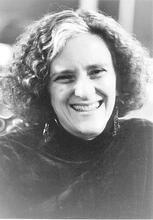Agudat Israel: Interwar Poland
During the post World War I era, Sarah Schenirer, a Polish seamstress with a passion for Jewish tradition, developed the first school system for Orthodox girls in history. By the eve of World War II, the network encompassed over two hundred and fifty schools with more than forty thousand pupils, primarily in Eastern Europe. Pictured here is the second graduating class of the Bais Ya'akov in Lodz, Poland, in 1934.
Institution: Yehudis Bobker, Sydney, Australia.
Agudat Israel, the interwar world movement of Orthodox Jewry, introduced substantial reforms that changed the status of women in Orthodox society. Its Bais Ya’akov model, pioneered by Sarah Schenirer, focused on women’s education as a way to create a more robust Orthodox community to withstand the pressures of modernity. Young Polish Jewish girls, for lack of a formal Jewish education, often attended local public schools, and often encouraged their families to modernize. Agudat Israel used Beis Ya’akov schooling as a way to fight this trend, making women instead into informal Jewish leaders within their home.
Founding of Agudat Israel
Agudat Israel, the world movement of Orthodox Jewry, was founded in May 1912 at a conference held in Kattowitz, Upper Silesia, in the German Empire (now Katowice, Poland). The movement’s founders, mostly from the separatist Orthodox community of Frankfurt-am-Main, wanted to enlist the large masses of Orthodox Jews in Eastern Europe and their spiritual leaders in the struggle against Zionism and other secular ideologies. Though representatives of A member of the hasidic movement, founded in the first half of the 18th century by Israel ben Eliezer Ba'al Shem Tov.Hasidic courts and Lithuanian yeshivot attended preliminary discussions and also participated in the Kattowitz conference, organizational work in Eastern Europe came to a halt with the outbreak of World War I. The Polish branch of Agudat Israel, initially called Agudat ha-Ortodoksim (The Orthodox Union) was founded only in 1916, during the German occupation of former Russian Poland. In the interwar period Poland became the major arena of the party’s activity, in both the political and educational realms.
The name Agudat Israel is derived from a passage in the Jewish Days of Awe Lit. "standing." The primary element of each of the three daily prayer services.Amidah liturgy that speaks of all creatures forming “one union” (agudah ahat) to do God’s will. Established in order to preserve the traditional Jewish way of life and to counter the influence of competing secular or religious ideologies, the party’s rhetoric emphasized that it regarded itself as little more than an organized expression of traditional Judaism as practiced throughout the centuries. Nevertheless, in practice it adopted a series of ideological and organizational innovations. The very act of organizing an Orthodox political party was in itself a concession to the sociopolitical exigencies of the time, which more extreme Orthodox elements opposed on principle. Nowhere would the innovative side of Aguda’s work be more visible than in the area of women’s religious education and youth activities.
Agudat Israel’s Perspective on Women
The party’s general stance on women’s roles reflected an oftentimes uneasy merging of highly conservative positions on issues of principle with grudging acceptance of modern organizational techniques and the politicization of Orthodoxy as necessary to ensure the survival of religious Jewry in the new conditions of Jewish and general society. Thus the party consistently opposed granting women the right to vote in kehillah elections (in fact, during the entire interwar period women never gained this right). During the 1922 general parliamentary election campaign, when Agudat Israel joined other Jewish and non-Jewish parties in the National Minorities Bloc, the party found its views on this issue challenged by representatives of women’s organizations. At that time, Aguda leader Eliahu Kirshbraun responded by making a distinction between general political affairs and Jewish communal politics. In the former, Aguda supported full equality for women. In Jewish life, however, Jewish women could not have equal rights in religious affairs, because they had different duties. This was not an Aguda political position, he maintained, but the policy dictated by the authoritative Jewish law codes. On the more limited issue of female suffrage in kehillah elections, he restated the principle that only religious Jews should decide religious questions. In other areas of kehillah activity, Aguda had no objection to equality for women. This answer avoided the issue of Orthodox women, but the standard opinion of rabbinical scholars of the time forbade women from voting for or being elected to kehillah office. As far as Aguda was concerned, the matter was closed.
The Role of Women in Agudat Israel’s Judaism
If women did not have a formal political role, this did not mean that they had no function in the strengthening of Jewish life in Poland or even in the long-term political success of Agudat Israel. Aguda publicist Alexander Zyshe Frydman rejected women’s participation in the ongoing political work of the party as a matter of religious principle:
… It is clear that presenting a demand for help of women in the realm of technical organization not only is insufficient, but also impossible. The young girl is busy with her own education, her studies and her activities for her “Benot” organization. The grown woman, on the other hand, is busy with her work in the home and the family, because of which she is exempt even from part of the commandments (time-bound). In addition, there exists among us the custom and the rule: “Kol kevudah bat melekh penimah” [Psalms 45:14, interpreted as “All glorious is the king’s daughter within the palace”] and it is not our goal and is not in our spirit to carry the woman into the tumult of public party life.
On the other hand, Frydman maintained that women had a crucial informal role to play in molding the younger generation and generating loyalty to Orthodox Judaism and to the Agudat Israel party:
What, then, must be our most urgent task at this moment?—to educate at the least the younger generation in the Agudist idea, a generation for whom Agudism will be part of its very being. … But the education of such a generation and its training are possible only when the Jewish mother and the sister of the present will create, through constant daily activity in the home and the family circle, the proper Agudist atmosphere … through their expressions of support or dissent, in the way of their reaction to all kinds of phenomena in Jewish life. … Upon the Jewish woman rests the obligation to recreate the “house” of those who fear the Lord.
Note that Frydman assigns to the women and girls the mission of educating not just to Jewish traditions and ideals, but also “to inspire the hearts of her children, her brothers and sisters, to the Aguda ideal.” This is an implicit acknowledgement of the role of women in the ongoing ideological battle being fought within Polish Jewry, where women often functioned as engines of modernization, urging spouses or siblings to follow the path of acculturation. For the spokesmen of Agudat Israel, those same women could equally well inspire their families to hold fast to tradition and be proud of their heritage. Subtle gestures and signals, no less than explicit expressions, determined the atmosphere of the home. Women had to realize their power and influence if a new generation of loyal Aguda members were to come into being.
Appeals to women to take up their sacred mission could also contain implicit and explicit criticisms of Orthodox women for straying from Jewish culture and thus endangering Jewish survival:
… to our sorrow, how numerous among you women and girls are those knowledgeable in the history of so many other peoples, but not of their own people. They are aware of the writers of the nations, but not of the people of Israel. And because of this they know to appreciate only foreign culture, without having any concept of the nature or the uniqueness of their own people, of the richness of its culture, of its happiness and suffering. And not only this, but many of them also relate with disparagement, or even hatred, towards our most sacred values.
What had caused this situation? Among other things, the different obligations of men and women regarding Torah she-bi-khetav: Lit. "the written Torah." The Bible; the Pentateuch; Tanakh (the Pentateuch, Prophets and Hagiographia)Torah study, from which women were exempt. One of the major innovations instituted by Agudat Israel in the interwar period, the introduction of formal religious education for girls, aimed at correcting this situation. Within the Agudat Israel movement there developed a number of subsidiary and auxiliary organizations, three of which were for women and girls. These were Benot Agudat Israel (Agudat Israel Girls) and its junior movement called Batya (founded 1925/6), Neshei Agudat Israel (Agudat Israel Women, founded 1929), and the educational network Bais Ya’akov (first school founded 1918).
Women’s Organizations and Their Roles
Of these organizations, that of Neshei Agudat Israel appears to have been the least active, leaving little imprint on contemporary or later accounts of party life. (Even the local supervisory committees for the Bais Ya’akov girls’ schools seem to have been male only.) Its very existence, however, attests to the growing politicization of Jewish communal life in interwar Poland, where every party developed a virtually cradle-to-grave system of party branches, schools, youth movements, loan banks, cultural organizations, and women’s organizations. Agudat Israel, though claiming to be the party of tradition, imitated its competitors, a fact that these competitors took pains to point out. In a newspaper article, Zionist leader Yitzhak Gruenbaum (1884–1964) expressed undisguised rage at the way that Aguda had found ways to adapt itself to new conditions. He pointed to the Aguda newspaper, the Bais Ya’akov schools, and Aguda’s work in Palestine, noting how all these things had been condemned by Orthodoxy only a few years earlier. While not denying that it had taken up the tools of its rivals, Aguda spokesmen consistently maintained that these were but instruments for preserving tradition and, furthermore, Aguda’s organizations were different in style and substance from those of its competitors.
The major innovations introduced by Agudat Israel for girls and women were those in education and youth activities. While in education for boys Aguda worked to upgrade and reform the existing institution of the Lit. "room." Old-style Jewish elementary school.heder, in education for girls Aguda took the even more drastic step of introducing formal Jewish education, contrary to previous traditional custom in Eastern Europe. Its recognition of the need for such education reflects changing Orthodox perceptions of the nature of contemporary Jewish society. No longer could parents depend on informal Jewish education and the home atmosphere to keep their daughters Orthodox.
In Orthodox families in late nineteenth- and early twentieth-century Poland, education for boys and girls differed greatly. While boys went to heder and devoted most of their time to Torah study, girls went to Polish schools, at best learning to read and write Yiddish and sometimes Hebrew from private tutors. In the Polish schools and gymnasia, even those with Jewish instructors, Polish language, literature, and culture dominated the curriculum. Memoirs from this period recount incidents of daughters of Hasidic families who came to mock their pious parents and who scoffed at the idea of marrying a Lit. "teaching," "study," or "learning." A compilation of the commentary and discussions of the amora'im on the Mishnah. When not specified, "Talmud" refers to the Babylonian Talmud.Talmudic scholar.
The Rise of Bais Ya’akov
Several rabbinical conferences pondered the possibility of setting up schools for girls, but rejected the idea. During the German occupation of Poland in World War I, representatives of German Orthodoxy set up a girls’ school in Warsaw. In the end, however, the initiative for founding the schools for girls that became known as the Bais Ya’akov schools came from a woman, Sarah Schenirer, a seamstress who herself became the subject of legend. Though both Schenirer (in an autobiographical sketch) and pious biographers note her devotion to study from the time of her youth, the immediate impetus for the Bais Ya’akov concept came during her sojourn in Vienna during World War I. By Schenirer’s own account, the evening lectures of Rabbi Flesch inspired her to translate her ideas about education for girls into practice. It appears that she also wanted to provide some kind of vocational training for young women, many of whom suffered poverty in the unsettled conditions of Poland during and immediately after the war. She returned to Krakow in 1917 and after some initial failures opened the first Bais Ya’akov school in the fall of that year, with twenty-five students in attendance.
Though the idea of Bais Ya’akov schools for girls did not originate with Agudat Israel, Aguda early on adopted and supported the fledgling movement. A group of leading Orthodox laymen in Krakow formed a committee to support Sarah Schenirer’s small school. These same men formed the nucleus of the Agudat Israel movement in Krakow; one of them, Moshe Deutscher, later served in the Polish Senate. At the first planning meeting of the Krakow Aguda in 1919 the assembled representatives decided to make Bais Ya’akov a regular part of their activities. This signified the first official “adoption” of the Bais Ya’akov idea by Agudat Israel. In 1922, this “adoption” gained national scope when Aguda established the journal Bais Ya’akov for the explicit purpose of spreading the Bais Ya’akov concept to new communities. The young Aguda activist and publicist Eliezer Gershon Friedenson (1899–1943) served as editor. Finally, in 1923 the world Aguda movement assumed partial financial responsibility for Bais Ya’akov when it decided to use funds collected by the party’s Keren ha-Torah (Torah Fund) to support Bais Ya’akov schools along with Aguda hederim and yeshivot.
The Growth and Success of Bais Ya’akov
Locally, the cooperation of Sarah Schenirer and Agudat Israel contributed to the spectacular growth of the Bais Ya’akov school network. An autobiography of a young woman from a Hasidic family (under the pseudonym “Esther”), submitted to a YIVO contest in the 1930s, testifies to this process:
A woman named Sarah Schenirer came to L. Her arrival caused an upheaval in our house. I had heard amazing stories about this extraordinary woman. People said that she was establishing schools for Jewish girls. … Then I went to hear Mrs. Schenirer lecture. I can remember how she spoke. Everyone applauded, and I clapped the loudest. To make a long story short, a Bais Ya’akov school was founded. My father worked actively on behalf of the school, often giving public lectures. It didn’t take long for the school to be opened. …
Sarah Schenirer traveled from town to town, inveighing against the passivity of Orthodox parents. How could they react so calmly to the sight of their immodestly dressed daughters sitting at the SabbathShabbat table and delving into non-Jewish books? She maintained that only special schools for girls, providing an education steeped in Jewish tradition, could stop the rising tide of assimilation. Schenirer’s personal appeal usually sufficed to convince hesitant Orthodox parents to set up a Bais Ya’akov school. Such local meetings took place under Aguda auspices.
With Aguda help, three main centers of Bais Ya’akov activity functioned simultaneously: the headquarters in Krakow, the office of the Bais Ya’akov Journal in Łódź (which also served as the headquarters of the Benot Aguda [Aguda girls] youth group), and the office in Warsaw which worked with the Horev organization in dealing with government authorities.
Statistics attest to the growing popularity of this new concept in Jewish education:
| Year | Number of Schools | Number of Students |
|---|---|---|
| 1917 | 1 | 30 |
| 1923 | 8 | 1130 |
| 1926 | 55 | 7340 |
| 1929 | 147 | 16,149 |
| 1935 | 225 | 27,119 |
In evaluating these statistics, it should be kept in mind that in most cases Bais Ya’akov schools provided supplementary Jewish education for girls who studied in public schools. Classes met on weekday afternoons and Sunday mornings, and more frequently during summer vacations. Furthermore, figures from the Joint Distribution Committee and other sources differ to some degree as to the size of the various Jewish school systems, including Bais Ya’akov.
Memoirs of Bais Ya’akov students stress their feeling of being “at home” in their Jewish school, as opposed to the Polish public school, the “house of Esau.” The autobiography submitted to the YIVO contest noted that “…naturally, I cherished the Bais Ya’akov school more than ever. I didn’t consider the public school to be ‘ours’, even though we were taught by Jewish men and women. Since they didn’t observe the Sabbath and always spoke Polish, as far as I was concerned they were ‘unfortunate people.’ I also felt that the way they taught religion was wrong. …”
The many extra-curricular activities carried on by Bais Ya’akov schools contributed to the home-like feeling. These included dramatic presentations, Sabbath and weekday lectures, and special Sabbath eve prayers.
In the 1930s Bais Ya’akov operated several types of schools in Poland. Full day schools existed in the large cities. Financial support for them came from the kehillot and city councils as well as from tuition payments. Unlike the Aguda schools for boys, the Bais Ya’akov curriculum had the same amount of secular studies as public elementary schools. In addition, Education Ministry officials, recognizing the religious nature of Bais Ya’akov, allowed Aguda to increase the hours of religious studies far beyond the amount of hours spent in public schools.
In smaller towns, Bais Ya’akov schools functioned as supplementary schools teaching exclusively religious subjects. The curriculum included the prayer book, Bible, basic Jewish laws, history, Hebrew, Yiddish, and ethics.
A third type of school—the Bais Ya’akov vocational school—came into existence in the last few years before World War II. A.M. Rogowy ran a commercial high school in Warsaw, while in Łódź E.G. Friedenson opened a trade school called Ohel Sarah (Tent of Sarah). The Łódź school trained some three hundred students, mostly from small-town poor families, in sewing, bookkeeping, and nursing.
The Teacher’s Seminary
The crown of the Bais Ya’akov movement was the Teachers’ Seminary in Krakow, founded in 1925. Under the personal supervision of Sarah Schenirer, this seminary trained hundreds of young women in secular and Jewish subjects as well as in pedagogy and psychology. Many of these young women went on to serve as teachers in Bais Ya’akov schools and as teachers of religion in public schools throughout Poland. Students’ memoirs of those years attest to the strong psychological impact of their seminary years. The atmosphere of this boarding school, with its twenty-four hour a day emphasis on piety, study and personal development strongly resembled that of the yeshiva. Besides the normal courses of study, the students participated in summer seminars either in Rawka or Jordanów. Former students, who now served as teachers in schools, also attended these seminars. This year-round, special educational program aimed to create a highly educated female elite who would serve as teachers in their own communities or other towns and would be the role models for an entire generation of Orthodox women.
The seminary graduates who taught in various communities seem to have frequently succeeded in communicating their special sense of mission. Decades later, their students recalled the profound effect the teachers had on them. The pseudonymous “Esther,” whose autobiography was mentioned above, shared this sense of mission even though she could not attend the seminary for financial reasons. Aware of her elementary Bais Ya’akov education and her other skills, a group of parents from a small town offered her the job of teacher in their local school. Upon her arrival, the young woman (all of sixteen years of age) discovered to her dismay that the school did not yet exist. She proceeded to organize the parents, recruit students, divide them into classes, and then began teaching the newly formed groups. A highly unusual but nevertheless enlightening example of the galvanizing effect of dedicated Bais Ya’akov teachers on a community can be found in Parysów. There the magnetic personality of a local girl recently returned from Kalisz caused a spurt of interest in Bais Ya’akov and in the Aguda youth organizations. Only later was it discovered that the teacher used her post to disseminate Communist literature among the Orthodox youth. Both Bais Ya’akov and the local Aguda never recovered from this blow. In hundreds of other communities, however, young women of Bais Ya’akov went about strengthening the ranks of Orthodoxy, the mission that Sarah Schenirer had inspired them to fulfill.
Aguda and the Polish Government
Like other Aguda schools, the Bais Ya’akov Schools often suffered harassment from government officials. Repeated interventions by Aguda representatives finally resulted in a series of ministry circulars that regularized their status. Since most schools merely supplemented public school education, the Education Ministry recognized them as private religion courses. This freed them from many of the curricular and financial obligations of full-fledged schools (March 14, 1926). A further order of October 10, 1927 instructed local officials not to interfere in the founding of new schools and not to prevent public school pupils from also attending the Bais Ya’akov schools. Aguda officials did not succeed in getting all Bais Ya’akov students exempted from the public school religion classes. This was part of a long standing but unsuccessful effort by Agudat Israel to upgrade the teaching of Judaism in the public schools. Teaching materials were in short supply. More importantly, religiously indifferent or even anti-religious teachers filled these posts. In the 1930s, as anti-Jewish discrimination increased in many spheres of Polish public life, schools would assign the religion classes to Jewish teachers already on the staff, whatever their religious convictions or knowledge, thus avoiding the necessity of hiring new Jewish teachers. Aguda officials and local rabbis tried to arrange for the local Bais Ya’akov teacher to be hired as the religion teacher or, failing that, some other religious person. As of 1937 these efforts were only partially successful.
Benot Aguda
Besides its pioneering work in formal education for women, Aguda also founded a special youth organization for women, known as Benot (or Bnos) Agudat Israel (Agudat Israel Girls). Once again, Sarah Schenirer and Eliezer Gershon Friedenson provided the driving force for the new group. Their purpose was to provide a congenial Orthodox atmosphere for girls aged fourteen to fifteen who had graduated from Bais Ya’akov schools. They called a founding meeting in Łódź in 5686 (1925/1926) to which six groups in the process of formation sent representatives.
From these humble beginnings, the organization grew steadily
| Year | Organizations | Members |
|---|---|---|
| 1926/27 | 25 | 750 |
| 1927/28 | 38 | 1,084 |
| 1930/31 | 91 | 2,950 |
| 1934/35 | 257 | 12,641 |
| 1936/37 | 279 | 14,132 |
Of all the Aguda sub-groups and allied groups, Benot Aguda exhibited almost no political consciousness and no internal upheaval. Of course, the organization had virtually no independent voice in political or cultural matters anyway. Local male advisory councils and a national male council supervised all activities. The propaganda pamphlets put out by Benot Aguda openly call the group a dependent organization. In national elections, members followed the instructions of Aguda central bodies and voted according to their directives. Beyond this, they had no political role.
The activities of Benot Aguda focused on culture and education. The national leadership and local chapters set up all kinds of evening and Sabbath classes, plus occasional lectures and meetings. Often the local Bais Ya’akov teacher organized and supervised the lectures and study groups of Benot Aguda. Like their counterparts in Po’alei Aguda and Ze’irei Aguda (the workers’ and male youth organizations of Aguda), the young women of Benot Aguda ran small Orthodox libraries and reading rooms, though the types of literature that sometimes appeared on the shelves reflect the very cultural gap that Bais Ya’akov and Benot Aguda attempted to abolish. Alongside the new works of Orthodox popular literature, the bookshelves might hold secular Polish novels, a far cry from the rabbinic tomes of the yeshiva students.
Although apolitical, Benot Aguda did have some social and economic tasks which the leadership of Aguda set for it. First of all, it instructed local groups to collect funds to support poor Bais Ya’akov students. In addition, the leadership envisioned the ideal Benot Aguda group running trade courses and, in large cities, opening an employment office for members and sympathizers. Other projected activities included visitation of orphan homes, and fundraising for Aguda summer camps and Bais Ya’akov schools in Palestine. The available evidence indicates that in most cases the local Benot Aguda chapters did not possess the resources or personnel to embark on such large-scale social projects, but concentrated their efforts on educational programs.
In many cities, this extra-curricular activity began during the school years. Benot Aguda formed an auxiliary group called Batya that ran after-school and Sabbath programs for the students of the Bais Ya’akov schools. Once again we observe the usually unstated, but nevertheless evident direction of Aguda policy: to preserve the Orthodox way of life by gathering as many segments of the Orthodox community as possible under its organizational wings. The formation of youth groups and formal education for girls involved significant departures from standard Orthodox practice. Yet Aguda felt itself forced to take up the tools of its adversaries and meet modernity head on.
In the 1930s Benot Aguda shared the growing interest in Aguda circles in the possibilities of emigration to Palestine. Young women worked at special training farms, hoping to receive one of the coveted “certificates” of entry to Palestine.
The ideological tracts and speeches addressed to the Benot Aguda membership reflect the different educational background of Orthodox women as distinguished from their heder or yeshiva-trained male counterparts in Ze’irei Aguda or Po’alei Aguda. Women usually had a less intensive Jewish education, but greater exposure to Polish language and culture. To meet this challenge, Benot Aguda preached a doctrine of Jewish pride, opposition to modern mores, and promotion of Yiddish as a spoken language. They subtly transformed the role of woman from that of a passive recipient of the values of the home to an educated, active defender of tradition. The modestly-dressed young Orthodox woman took her place not just in the new Benot Aguda organization, but in the chain of tradition that stretched back thousands of years. The autobiography of “Esther” gives us a glimpse of the inner world that the organization tried to create: “at this time [age fifteen—GB] we were promoted from the youth organization Basya into Bnos Agudas Yisroel. We participated in a solemn induction ceremony, at which the speakers repeatedly stressed the exalted nature and significance of our duties. …”
In the view of Sarah Schenirer, the young Orthodox woman needed a sense of mission:
The Benot Aguda movement, which strives to educate loyal Jewish daughters, must go to war against immoral dress and create a new fashion, simple and beautiful, which fits Jewish standards of ethics and taste. We are forbidden to be ashamed of our Torah and the sanctified values of Judaism. On the contrary! We must show the whole world our pride in them. ... Once redemption came to Israel through the merit of pious women. Would that also now our deeds will hasten the time of redemption.
Women had to make a conscious decision to return to a fully Jewish atmosphere and to reject the superficially attractive but morally empty luxuries of modern life.
Though general Aguda educational policy included the introduction to the heder curriculum of secular studies taught in Polish, Benot Aguda went in an almost contrary direction and urged its members to speak Yiddish as a barrier to assimilation. Some critics of Aguda pointed to this policy as evidence of hypocrisy, but it merely reflects Aguda’s perception of the special problems of Orthodox young women. They had been most tainted by contact with secular culture and had to be brought back to their roots. As the Bais Ya’akov Journal put it in 1930: “Speaking Polish is not a sin, but speaking Polish because you’re ashamed to speak Yiddish is a great sin!” The Yiddish language was not a mere vessel, but constituted a unique “expression of the Jewish soul, of Jewish demands and strivings, of Jewish joy and sadness.”
Benot Aguda used Yiddish as the first line of defense against assimilation. In accord with this, in 1929 it abolished the Polish language section of the Bais Ya’akov magazine. At its national conference in 1937, it passed resolutions obligating Benot Aguda members to use Yiddish or Hebrew names, and to speak Yiddish as their everyday language of discourse.
The Legacy of Agudat Israel and Bais Ya’akov
To Agudat Israel, the education of future generations ranked among the highest of duties. All of its political efforts to protect Orthodox rights would be in vain if no one carried on the Jewish tradition. The besieged fortress of traditional Judaism needed skilled and indefatigable defenders, and this defense work Aguda saw as its raison d’être. On closer examination, however, it appears that the educational and youth activities aiming at the defense of Orthodoxy entailed more than a holding action; they also involved no small measure of adopting and adapting the tools, methods and even the vocabulary of Aguda’s political rivals. Without this transformation, they reasoned, Orthodoxy might lose the ideological struggle sweeping Polish Jewry.
The notion that people had to undergo a conscious process of training to become Orthodox and remain Orthodox had far-reaching implications. Education now had a much wider scope than the hours of formal instruction. It also addressed women, an entirely new constituency. The Aguda leaders did attempt to keep changes to a minimum, and some evidence hints that in some towns the reforms existed only on paper, but the programs for women represented clear innovations. The element of time should also be taken into consideration. Only in the 1930s did many Aguda programs get started, and only then did the Aguda organizational network reach most areas of Poland.
Nevertheless, Agudat Israel laid the groundwork for a new Orthodox generation, different from its predecessors. These young men and women grew up in the organizational structure of Aguda and they did not share the caution of their elders concerning organized Orthodoxy. The concession to reality made by the parents had become an established part of the world of the children.
In the Holocaust period, fragmentary evidence indicates that Agudat Israel continued its educational work for young boys and girls. As in the interwar period, Aguda saw the protection and promotion of religious education as its special responsibility. In the conditions of the ghetto, at least until the Germans permitted the Judenrat to open schools, this meant carrying on such activities in secret, which entailed considerable risk. Warsaw ghetto archivist Emanuel Ringelblum recorded in his Notes from the Warsaw Ghetto that the reports of Abraham Gancwajch to the Germans included information about the illegal hadarim operated by Agudat Israel. Using money from the Joint Distribution Committee and from a special fund set up by the Boyaner Rebbe, the educator Yehuda Leib Orlean secretly resumed his work with students and teachers from the Bais Ya’akov schools in Krakow and in the surrounding area. After Orlean fled to Warsaw, he continued his educational work there. In Warsaw, A.Z. Frydman used money from the Joint to set up hedarim, yeshivot, and Bais Ya’akov schools in the guise of public kitchens, play centers, or health organizations. All these schools surfaced in 1941 when the Germans gave the Judenrat permission to open schools for children, and they continued to function until the mass deportations from the ghetto began in the summer of 1942. One source lists a total of 2,250 students in Aguda schools in the Warsaw ghetto in 1940, and some 3,500 students in such institutions in 1941.
Bacon, Gershon. The Politics of Tradition: Agudat Israel in Poland, 1916–1939. Jerusalem: Magnes Press, Hebrew University, 1996.
Frydman, Alexander Zyshe. Selected Writings (Hebrew). Jerusalem: 1960.
The Bnos Agudat Israel Organization (Yiddish). Łódź: 5690 (1930).
Schenirer, Sarah. A Mother in Israel: The Writings of Sarah Schenirer (Hebrew). 4 vols. in 3; Tel Aviv: 1975.
Shandler, Jeffrey ed. Awakening Lives: Autobiographies of Jewish Youth in Poland Before the Holocaust. New Haven and London: Yale University Press, 2002 [autobiography of “Esther,” pp. 321–343].
Weissman, Deborah. Bais Ya’akov, A Women’s Educational Movement in the Polish Jewish Community: A Case Study in Tradition and Modernity. Unpublished MA thesis; New York University: 1977.
Weissman, Deborah. “Bais Ya’akov: A Historical Model for Jewish Feminists.” In The Jewish Woman: New Perspectives, edited by Elizabeth Koltun, 139–148. New York: Schocken Books, 1976.

